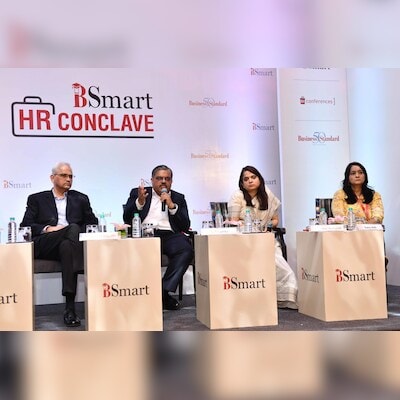)
L to R – Ramesh Mitragoti, Group Exec President-HR, Aditya Birla Group; DP Nambiar, VP-HR, TCS; Rajkamal Vempati, Head Human Resources, Axis Bank; Saba Adil, CHRO, Edelweiss Life Insurance at BSmart HR Conclave in Mumbai | Photo: Kamlesh Pednekar
The fast-changing technology landscape and hiring trends are nudging industry executives to take a fresh look at how they hire.
This has been accentuated by the need for culture assimilation for the large size of recruitments undertaken during the pandemic, said HR executives at Business Standard’s BSmart HR Conclave in Mumbai on Wednesday.
“Flexibility is no more a benefit, but a commodity. The workforce aspirations are changing. It’s our mindset, it is not that employee work is not happening if you don’t see it,” said Rajkamal Vempati, head of human resources at Axis Bank, which operates workforce on a hybrid model.
The bank’s pilot project of posting 50 freelance jobs with a remote work option during the pandemic attracted more than 50,000 applications, Vempati explained.
Tata Consultancy Services (TCS), however, has been urging the workforce to return to office.
D P Nambiar, vice-president-HR, Tata Consultancy Services (TCS), said the need to assimilate new hires with the company’s ethos and culture, is driving the software major’s work from office (WFO) approach.
“There wasn’t any effect on productivity and efficiency. Where we believe there is a concern is that people, especially those who joined us during the course of the pandemic, may not have a good enough appreciation of what the organisation is all about, the values and ethos of this organisation, and what does this organisation stand for,” Nambiar said.
For companies like TCS, the goal is to cultivate a future leadership pool.
“If they don’t have that (organisation values), they won’t be able to fully leverage all the opportunities. Gradually as some of them move into mid-level leadership roles, they would not be able to represent the organisation adequately,” Nambiar added.
Nambiar’s sentiments were echoed by Ramesh Mitragotri, group executive president HR, Aditya Birla group.
“For most organisations, why it (work from home) worked very well is the set of people who were used to working together dispersed and worked remotely. It takes time to build that bond and create that team. The first action was that people had to be brought back,” Mitragotri said.
The panel also noted that there has been a change in hiring trends.
Saba Adil, CHRO for Edelweiss Life Insurance noted, while the process of hiring remains the same, “What we look at in people at the time of hiring has definitely changed.” Adil added, “Now, what we look for in terms of the outlook to jobs, is the resilience they (people) bring into the organisation, the learnability that people carry on, and those are things that we are looking out for more.”
At Axis, the new hiring trends include giving the ‘interview’ process a miss for certain roles. Vempati noted that, for certain positions, the bank now solely relies on analytics and other tests for selection.
While the panel agreed technology is shaping these HR trends, the opinion on the extent of its adoption remains divided.
Mitragotri from the Aditya Birla group, said the decision has to be value-driven.
He said, “Just because my competitors are using something, I shouldn’t be rushing it. There is an opportunity for the organisation to multiply what it does.”
On tech-related adoptions, Mitragotri does not expect it to cut down on job opportunities, but build on productivity.
He said, “In the current phase of what is called Industrial Revolution 4, technology is coming in aspects whether it is Chat GPT, and other information flow, this will not take away jobs but if utilised properly, it will improve the situation. That’s an opportunity for the organisation to multiply what it does. Productivity increases. The issue is that new roles emerge for what you do with it.”
For Nambiar, the client rules in decisions pertaining to tech adoptions.
“What we’re trying to do is to strike a balance so that technology adoption complements what we are doing and adds value for us and our customers,” he said.
“We continue to make significant investments in upskilling our people in all upcoming technologies,” he added.
Vempati, however, encourages a bold approach.
“The right point is the problems it is solving and the problems it is creating. That being said, the after steps are important, and the mindset to change. I think that is where HR steps in to get the mindset quotient up,” Vempati added.
First Published: Aug 28 2024 | 10:08 PM IST
